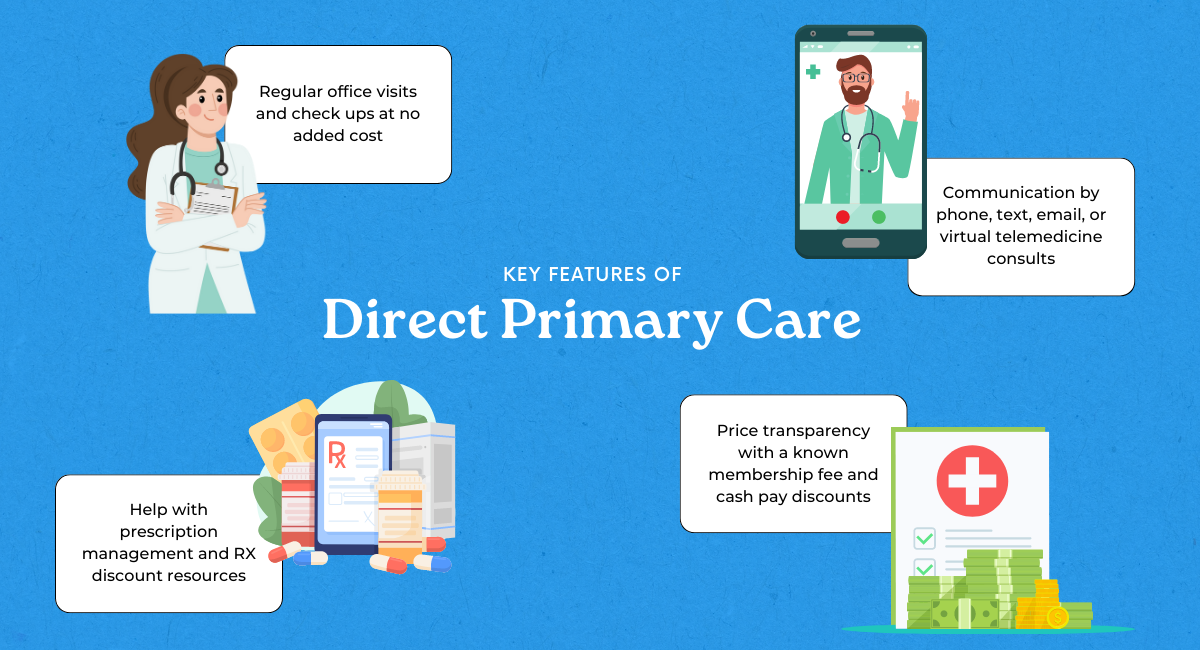What is Direct Primary Care and How Does it Work?
What is primary care?
Primary care is the healthcare you receive from a physician who specializes in family medicine, general internal medicine, or general pediatrics. They are sometimes thought of as the “family doctor.” This is the physician or the medical practice that provides routine care such as annual physicals or “check-ups.” They also provide a wide range of medical care for common illnesses like strep throat, cold, flu, fever, sinus or UTI infections, annual vaccinations, care for allergies, hypertension, digestive issues, and many more. In addition to these common conditions, they help manage chronic disease and may detect changes in your health that indicate additional risk or progression of an underlying health condition.
Primary care physicians should be familiar with your health history, health preferences, and all medications you take to help prevent any contraindications with other medicines. They can also provide pain management care and refer you to a specialist for a specific condition. In essence, they provide and coordinate all your routine healthcare services to promote good health, prevent disease, provide patient education, and in many cases, are the first to diagnose acute illnesses. Acute illnesses come on rapidly but are generally resolved within a short period of time.
What is Direct Primary Care?

Direct Primary Care (DPC) is a non-insurance membership-based healthcare model that provides expanded access to a primary care physician and high-quality care at an affordable cost. The popularity of the Direct Primary Care model has grown rapidly as a healthcare option for people that want greater access to personalized care, the freedom to choose their provider, and a more engaged relationship with their primary care physician.
Direct Primary Cares do not bill third parties on a fee-for-service (FFS) basis for services provided. Instead, patients pay a monthly or annual membership fee for access to all services provided by the DPC practice.
Since there will be medical events that exceed the scope of primary care, patients are encouraged to also have a way to manage large, unexpected healthcare costs such as a medical cost sharing membership.
Why are physicians choosing the Direct Primary Care Model?
The Direct Primary Care Coalition (DPCC) “represents primary care physicians, healthcare associations, employers, and others who support the advancement of state, federal, and private sector policies that bring patients and physicians together to help promote better primary care.” The DPC Coalition and American Academy of Family Physicians collaborated with Milliman and the Society of Actuaries on a comprehensive evaluation of the Direct Primary Care (DPC) model. Results in the Society of Actuaries Report included a market survey with key findings that shed light on what’s motivating DPCs to move away from the traditional health insurance primary care model. From a pool of 200 DPC physicians, they learned that the primary motivators for physicians choosing to operate a DPC practice included:
Potential to provide better primary care under a DPC model (96%)
Too little time for FFS visits (85%)
Too much FFS paperwork to complete (78%)
In addition, the DPC physicians in the market survey reported having better overall personal and professional satisfaction in:
Ability to practice medicine (98%)
Quality of primary care (98%)
Relationships with their primary care patients (97%)
What are the core principles of Direct Primary Care?
Direct Primary Care physicians are often passionate advocates of free market healthcare. Direct Primary Care is relationship and patient-centered. Because it is a membership or subscription-based approach, DPCs can limit the number of patients in their practice. They have the time to deliver high-quality, highly-engaged care and spend more time:
Listening to their patients
Assessing patient health history
Addressing their current health concerns
Determining the best medical course of action
DPC physicians spend much less time on administrative processes and have a decreased practice overhead which makes their services affordable.
What are the key features and benefits of Direct Primary Care?

Not all DPC practices are the same but generally, they include:
Regular office visits and checkups at no added cost.
Unlimited access including office visits and communication by phone, text, email, or virtual telemedicine consults (in some cases, the access is 24/7).
Extended appointment times — generally 30-60 minutes.
Reduced wait times to get an appointment — often it’s the same or the next day.
A thoughtful and considerate focus on preventive care and wellness. This includes screening and vaccinations, basic lab tests, and diagnostics.
Help with prescription management and RX discount resources.
An enhanced doctor/patient relationship. This includes a deep understanding of your health status and treatment options.
Help navigating a complicated healthcare system including referrals to specialists.
Price transparency with a known membership fee and cash pay discounts on other healthcare services.
What are the pros and cons of the DPC Model?
The pros of a DPC membership include:
Affordability
High-quality care
A better doctor-patient relationship
The cons are few. However, there is a disadvantage for those who live in rural or underpopulated communities. They may find it difficult to find a DPC practice.
An in-depth report by Hint Health, “Trends in Direct Primary Care 2022” states, “DPC membership across the U.S. has increased 241% from 2017 to 2021,” yet there is a shortage of physicians in rural areas regardless of the healthcare delivery model.
According to the article, “Provider Shortages in Rural America,” “The relative shortage of physicians in rural areas of the United States is 1 of the few constants in any description of the US medical care system. About 20% of the US population—more than 50 million people—live in rural areas, but only 9% of the nation's physicians practice in rural communities.”
How can I find a Direct Primary Care doctor near me?

Even after you’ve enrolled in a DPC membership, if you relocate too far away from that practice, you’ll need to find another one in your new location. To help our Medical Cost Sharing Community find Direct Primary Care, Sedera developed a DPC Finder. This tool maps out the locations of DPCs across the nation. You can search by zip code or practice name. DPCs can request to be added to the finder and be part of the Sedera DPC cross-referral program by filling out this form.
What should I ask before enrolling in a Direct Primary Care membership?
Here are a few important questions you should ask to help you decide if the Direct Primary Care practice you’ve selected is a good fit for you.
What is the physician’s medical background and expertise?
Is the physician Board Certified? If so, in what specialty?
What services does the DPC Membership include?
How many patients are enrolled in the practice?
What is the average wait time for appointments?
How long will the appointment be on average?
How does the office handle after-hours and emergency care?
What are the communication policies? Do they include texts, emails, or direct calls to the physician?
Does the physician provide referrals to specialists?
How are lab tests, diagnostic imaging services and prescriptions handled?
Are telemedicine or home visits offered?
Are there exclusions or limitations to the provided services?
How are long-term and chronic conditions handled?
What are the policies around member cancellation if needed?
Is there a minimum contract or time period for membership?
How do Direct Primary Care and Sedera Medical Cost Sharing work together?

DPCs are leading healthcare in the right direction when it comes to free market choice, transparency, affordability, and enhanced patient care. Sedera pairs perfectly with that vision, provides a best-in-class Medical Cost Sharing experience, and leads with years of industry knowledge and integrity.
Direct Primary Care is a free-market healthcare solution for routine and preventive primary care. As a healthshare, Sedera is the solution for how to pay for large, unexpected medical events that exceed the scope of primary care. When paired, it’s a comprehensive, cost-effective, non-insurance solution for individuals and families to manage small and large medical events.
Here’s a great source to learn more about how Sedera Medical Cost Sharing works. And, if you’re looking for more information on how to choose a healthshare, here are some important questions to ask.
When Sedera Medical Cost Sharing Members pair their membership with a DPC membership, they have an efficient, cost-transparent, and affordable way to manage their primary and preventive healthcare needs — which is essential to achieving and maintaining their best health outcomes. At the same time, their Sedera membership gives them support from the Community for eligible, large, and unexpected medical costs.
For Direct Primary Care physicians, introducing Sedera to their patients means they have the answer to the question, “What if I have a large, unexpected medical event?” DPCs can learn more here about patient referrals to Sedera, and how we can grow together and help patients choose a better way to health.
One last question: Is Direct Primary Care worth it?
Based on all the previous questions and the information provided, we believe the answer is “yes.” Direct primary care can create better health outcomes and is worth strong consideration. Here’s a bit more information to explain why.
The Direct Primary Care Coalition (DPCC) has a list of five key tenets about the relationship between a DPC physician and their patient that improve the patient experience which includes:
Service
Patient choice
Elimination of fee-for-service
Advocacy
The fifth tenant is “Stewardship.” This is a concept that means the careful and responsible management of something entrusted to one's care. According to the DPCC, “DPC providers believe that healthcare must provide more value to the patient and the system. Healthcare can, and must, be higher-performing, more patient-responsive, less invasive, and less expensive than it is today. The ultimate goal is health and well-being, not only the treatment of disease. DPC providers are committed to ensuring that American healthcare delivers on these goals.”
When Sedera Members have affordable and convenient access to Direct Primary Care, they may be more likely to seek preventive and immediate care for an acute condition. This may prevent progression into a more serious illness and reduce costly emergency care services.
Our Members understand the power of Community and that we are here to support each other and to share each other’s medical burdens. By being proactive and committing to taking good care of their health, our Members also protect the financial health of the Sedera Community, leaving more resources to support their fellow Members.
Sedera is a nonprofit Medical Cost Sharing Community that offers a non-insurance approach for managing large and unexpected medical expenses through a membership-based community. Sedera Members belong to a Community of individuals who are active and engaged participants in their healthcare decision-making, dedicated to a healthy lifestyle, and united by shared values.
SEDERA DOES NOT PROVIDE MEDICAL ADVICE. The information contained herein is for informational and/or educational purposes only and is not intended or implied to be a substitute for professional medical advice. Always seek the advice of your physician or other qualified healthcare provider with any questions you may have regarding a medical condition or treatment.